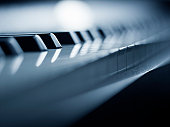
Home > Piano Techniques > Legato
|
||||
Legato Piano Playing Technique
No, it’s not the language of the soul or the language of art or something lame like that. It’s Italian. All musical notations are written in Italian, so whether you’re from Russia, China, or Zimbabwe, “loudly” in music is fortissimo and “slowing down” is ritardando. Another important Italian notation, legato, means “tied together” although in music is better meant as “to play smoothly.” Legato piano playing is actually so important and common that there are in fact two ways this notation is expressed: by the written word and also by its own unique symbol. Legato stands as such an important concept to piano playing because it expressed not just what to play, but how to play particular notes, passages, or entire songs. Legato refers to a kind of articulation for notes and is reflected in piano playing techniques that pianists use. Unlike stringed instruments, no single note on a piano can be played legato all by itself. Instead, legato expresses the way a certain range of notes, from two to two thousand, are played so that they blend one into the next within any specific punctuation or empty space between notes. A good contrast to legato is the notation staccato, which means that notes are played very separately from one another, producing only very short tones with momentary gaps of silence between them. To hear this difference between legato and staccato on piano, try playing the first five notes of a C major scale two different ways. First, play C, D, E, F, and G with short, abrupt staccato notes, only tapping the keys and lifting your finger off very quickly before playing the next note.
This will produce tones that blend into each other. Be careful not to press notes for too long. Legato does not mean holding notes longer than their rhythmic indication – can you imagine holding C, D, E, F, and G all at the same time? Ouch. Normally, a writer will indicate the specific instances when legato piano playing is necessary. At the top of the music, near the tempo notation, composers may state something like “poco legato” or “sempre legato,” which is more Italian indicating how smoothly the notes ought to be played. However, the more common way of expressing when legato is necessary is not with words, but with a curved line that connects two different notes together. Sometimes curved lines will connect two of the same notes together, meaning that the performer should hold that individual note instead of striking it again; however, when the curved line connects two different notes, it means that everything within the bounds of that curved line should be played legato. This curved line might be between two notes, or could expand for many measures. Be sure to pay careful attention to when passages are bound with this curved tie, and when they are not. When a composer indicates that a passage ought to be played legato, this means that the notes should smoothly flow from one to the next, producing a fluid, blended sound. But when that line is not hovering over the keys, just play normally and brush up on learning your other Italian phrases. This lesson was brought to you by Piano System
http://pianoplayerworld.com/PianoSystem.html
| ||||
|
Although every attempt has been made to make information as accurate as possible, we are not responsible for any errors that may appear.
 Musicians across the world find that no matter what country they are from or
what language they speak, they are united by a common language.
Musicians across the world find that no matter what country they are from or
what language they speak, they are united by a common language.
 Your fingers should only contact the keys long enough to emit a quick
sound, then should be lifted immediately. Now, try playing those same notes again, but with legato notes.
Instead of lifting your fingers off of the notes quickly, let each finger stay on its key just long enough so
that the next finger begins playing its note.
Your fingers should only contact the keys long enough to emit a quick
sound, then should be lifted immediately. Now, try playing those same notes again, but with legato notes.
Instead of lifting your fingers off of the notes quickly, let each finger stay on its key just long enough so
that the next finger begins playing its note.



